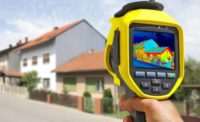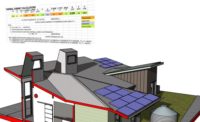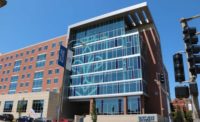“Making nature visible is a way of reacquainting us with wider communities of life, but it also informs us about the ecological consequences of our activities” (Cowan, Stuart, and Sim Van der Ryn. Ecological Design. Washington, DC: Island Press, 1996.) Sustainable design enhances civilization without destroying biodiversity and natural environments. Ecological design reduces negative environmental effects by integrating itself with living processes. Unlike the current finite system of design, an integrated cooperative system of sustainable and ecological design, called ecological sustainable design, is required to promote infinite ecological processes, purposes and productivities. This article will demonstrate how a building envelope consultant as part of a project team can assist with the implementation of ecological sustainable design to enhance the quality of human and natural life in the built environment.
A higher education building, DeAnza College’s Media and Learning Center, in Cupertino, Calif., serves as a case study for implementing ecological sustainable design. The building, a two-story, LEED Platinum structure, includes 65,000 square feet of media and learning center space. It also features a buoyancy-driven natural air ventilation system, more than 6,000 square feet of photovoltaics, vacuum-tube style solar thermal collectors, and it is clad with a terra-cotta rain screen system, metal wall panels and an aluminum-and-glass curtain wall system (Figure 1). A central atrium includes skylights and clerestory windows, and its steep-sloped roof is clad with a standing-seam metal roof. At the building perimeter, louvers serve as air intakes for the ventilation system. Other portions of the roof consist of a single-ply membrane that meets ENERGY STAR, LEED and Cool Roof Rating Council requirements for reflectivity and emissivity. The project’s east-west orientation maximizes energy efficiency while creating space for a new public quad. Its landscaping addresses rainwater quality and quantity and offers an indoor/outdoor student lounge and breakout areas. Ecological sustainable design for this building is achieved by incorporating natural patterns, minimizing energy consumption and connecting occupants with nature.
Natural Patterns
Natural patterns are observable consistencies found in the natural world. This building’s passive ventilation, atrium daylighting, passive sun shading on the south façade and vacuum-tube style solar thermal collectors are based on natural weather patterns and also utilize the sun’s trajectory. The buoyancy-driven passive ventilation system is able to circulate air to more than 80 percent of the building without the use of fan power and ductwork. As compared with conventional mechanical systems, the buoyancy system delivers air changes per hour that significantly exceed the norm for buildings of this type. The system draws outside air through louvered ventilation towers located at various locations on the building perimeter (Figure 2). Weather stations at the roof level control louver operations and air flow volumes into the ventilation towers (Figure 3). The air then passes over cooling coils, decreasing its temperature, and then it descends through ventilation towers and into the underfloor air plenums. Floor diffusers circulate the air into the interior space. If occupants demand warmer air temperature, heating coils in the plenum can warm the underfloor air as needed. Exhaust air is collected in ceiling plenums which then direct air into the central atrium space where it exits through louvers in the atrium clerestory, creating a chimney-effect. In addition, the rooftop vacuum-tube style solar thermal collectors supplement the central campus hydronic system’s delivery of hot water to the buoyancy system coils (Figure 4).
The ventilation shafts, positioned along the building perimeter, are clad with metal panels and an insulated wall assembly (Figure 5). The wall assembly from the exterior to the shaft side consists of metal panels installed over a vapor-permeable air barrier, sheathing, insulation, sheathing and sheet membrane at the shaft exterior wall. From the shaft interior to the building interior, the wall assembly consists of sheathing, a vapor barrier, insulation and interior sheathing. As the building envelope consultants, we reviewed design concepts and alternatives for the exterior wall cladding, windows, doors and roofs, which included providing recommendations for the interior and exterior air and vapor barriers at the tower shafts for the building’s ventilation. We considered the effects of thermal loading on the building, which included the outdoor air temperature. Cupertino’s climate zone is defined by hot and dry summers with large daily temperature swings and cool winters requiring heating on many days. As a result of these climatic shifts, the relative humidity and temperature of these spaces vary greatly during the year. The design decision to include two types of vapor barriers at the ventilation shaft wall assembly necessitated further analysis to determine the location of the dew point within the wall cavity and the potential for moisture accumulation within the wall assembly. Dew point is the temperature at which moisture in a sample of air will condense into liquid. Determining the dew point is important because condensation will occur on surfaces that are colder than the ambient dew point, a condition which could result in interior moisture, water damage to interior finishes and biological growth.
Sun position serves as the second natural pattern in this case study. Passive solar shading—louvers and canopies—at south-facing glazing reduces solar heat gain. The building’s sloped skylight roof, positioned with its photovoltaic collector field facing south, and clerestory windows, positioned to the north to optimize daylighting and minimize glare, allow natural light to illuminate the central atrium and interior of the building—reducing the dependency on artificial light (Figure 6). Occupants experience the sun’s natural patterns as they pass through this space. To ensure that the desired performance and integration of the skylight and clerestory windows are achieved, we recommended both a visual- and performance-based mock-up to demonstrate how the windows would incorporate with adjacent wall cladding systems. Although windows are often tested and certified by the manufacturer, these test results are not project specific and are not assurances of the installed assembly’s performance. Our recommendation for mock-ups confirmed that the design intent met the project goals for performance, daylighting optimization and glare reduction with the requisite waterproofing.
Energy Consumption
According to University of California, Berkeley professor emeritus of architecture Sim Van der Ryn and freelance ecological designer and writer Stuart Cowan, 40 percent of the United States’ energy consumption is associated with building construction, materials and maintenance. Building energy reduction is important for ecological sustainable design because in nature there is no energy waste. For this case study, energy consumption is reduced through the use of passive ventilation, natural lighting, building cladding design, photovoltaics integrated into a sloped skylight, rooftop vacuum-tube style solar thermal collectors and standing-seam metal roof, which thereby decrease the demands for mechanically based heating and cooling and reduce annual electrical costs. Also, the effects of solar radiation are reduced by passive solar shading, by south-facing low-emissivity glazing and by 70 percent opaque fritted glass on the sloped skylight. Through implementation of these strategies, this building reduced energy consumption by 71 percent compared with the regional average for higher education buildings.
The cladding design incorporates both metal panels and terra-cotta rainscreen installed over a vapor-permeable air barrier applied to exterior sheathing (Figure 7). A building envelope analysis determined the appropriate wall and roof assemblies and ideal location for the air and vapor retarders and insulation within the assembly. This analysis also determined the most efficient finish material to prevent condensation and the influence of weather on the cladding assembly. By virtue of their design, the terra-cotta rainscreen and metal panels have an air gap between the building and the cladding; this air gap serves as additional insulation and increased energy efficiency, thereby reducing thermal loading. We provided recommendations for the air barrier behind the building cladding—giving consideration to the relative humidity and temperature of the building, as previously described. We also considered the vapor permeability of the weather barrier behind the cladding and the tradeoffs between installation of either a fluid-applied membrane or sheet membrane behind these systems (Figure 8). These considerations included quality control, ease of detailing and installation at penetrations and terminations, compatibility with adjacent materials and UV stability. Our experience has been that a sheet membrane provides better quality control by relying less on field application of the waterproofing membrane. However, each project should be evaluated on a case-by-case basis to meet the needs of the client and project budget. Between the building cladding system and curtain wall, we also recommended dual-stage sealant joints at all panel joints. A second sealant joint provides redundancy in the barrier wall system, and protecting the interior, primary seal adds durability and increases performance of the wall system.
Further reducing the building’s demand for electricity generated offsite is a photovoltaic collector field integrated with the sloped skylight and standing-seam metal roof (Figure 9). We provided consultation services on the photovoltaic collector field mounting system at the seams in the standing-seam metal roof and the standing-seam metal roof’s integration with the sloped skylight. We recommended the metal roof assembly consist of metal panels over a drainage layer over a high-temperature self-adhered sheet membrane over decking with insulation. The drainage layer provides a drainage plane for incidental rain water which could enter through the metal panel joints and penetrations. It also provides an air space, separating the metal panels from coming in contact with the self-adhered sheet membrane. We also considered the thermal bridging effects of the photovoltaic collector field attachment of the standing-seam metal roof. The photovoltaic collector field anchorage and placement of insulation within the assembly had to be considered since thermal bridging through these individual building components can affect whole-building energy performance. Energy performance can be impacted because heat conducts through the path of least resistance, like highly conductive steel, and avoids thermally resistive materials, such as building insulation, thereby reducing the effectiveness of insulation and resulting in reduced energy performance. Our analysis determined the placement of insulation within the assembly to reduce conductive heat flow, thus lowering heating and cooling demands while minimizing the potential of condensation. By assisting the design team with the design performance criteria, energy-efficiency measures and reduction of thermal bridging effects, we helped to minimize the potential energy inefficiencies of traditional systems.
Connecting Tenants With Nature
This building employs ecological sustainable design and connects tenants with nature by way of the ventilation system, natural daylighting and sustainable landscape. Designers can initiate interest in sustaining natural systems and connect tenants to ecological systems by modifying our designs to engage a tenant with nature. In order for a designer to shift users’ association with their products, one must introduce both subtle and obvious ecological sustainable design ideas. Take, for example, daylighting. The reduced electrical requirement resulting from daylighting may be a subtle design component while a building feature, such as this building’s sustainable landscape with public access, may be more obvious to building occupants (Figure 10).
If designers can have users understand that sustainability touches every aspect of our lives, we may be able to change people’s behaviors. Our designs should resonate with people’s core values and make them consider the long-term impacts of their decisions. When we combine varying disciplines and collaborate with various design expertise, we can determine the best means for effectively changing people’s perspectives. The summation of individual expertise, where each idea is considered with respect to the whole, results in a well-integrated design. This integration of multiple design disciplines, resulting in imaginative ideas, allows our solutions to become richer and we progress—nature and humankind together.
Designers enjoy problem solving. Now, more than ever, our ecosystem depends on our capacity to generate innovative solutions today to carry us into the future. We need to reevaluate our design criteria from the conventional to that of the eco-conscious which incorporates ecological economics as well as human and ecosystem health. This idea of ecological sustainable design is recognizing and understanding the balance between that of human functions and that of nature by integrating natural processes. Ecological sustainable design also holds that designers minimize or eliminate their environmentally destructive effects while promoting the natural environment. As a designer, one must understand the land and its connections to nature, use the surroundings as a guide and create spaces ecologically that will forever meet the needs of people and of the planet. DeAnza College’s Media and Learning Center demonstrates that ecological sustainable design is possible for modern designed buildings.













